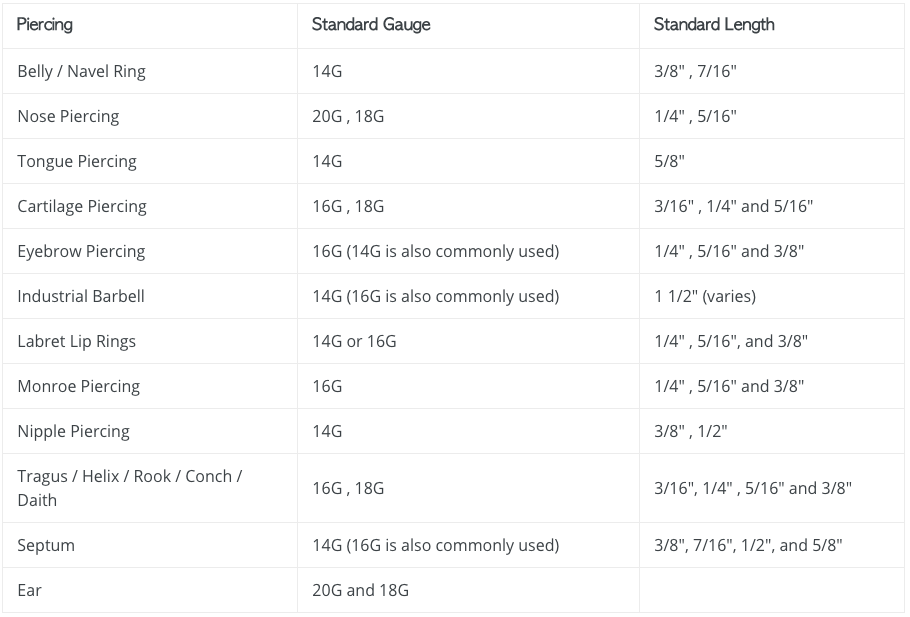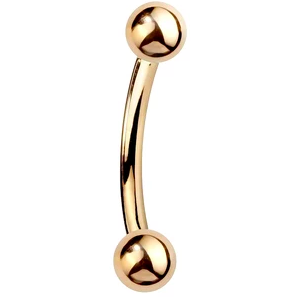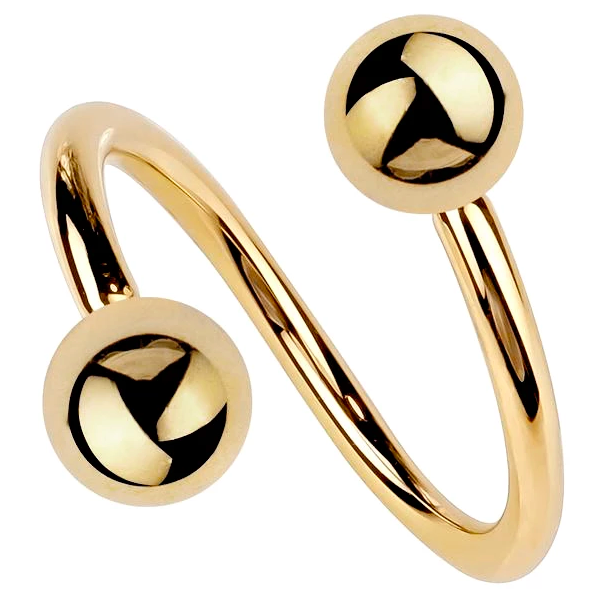
Your piercer finally tells you the words you’ve been waiting for weeks to hear: your new body piercing has fully healed.
Now, you can finally buy all of the body jewelry that you’ve been dreaming of since you built up the courage to sit in the piercer’s chair. But, once you start shopping around, you’ll probably find that buying body jewelry is a bit more complicated than purchasing a bracelet. You might be confused by terms like gauge and internal threading, not to mention the stress of deciding barbell length and hoop diameter.
As an online body jewelry retailer, we are no stranger to these questions. Buying anything online is a gamble, and it’s easy to buy the wrong jewelry size if you don’t fully understand how it works. We want you to be able to confidently shop for your next favorite body jewelry piece, so we’ve put together this quick and easy guide to buying body jewelry.
There’s a lot of diction in the piercing world, and if you’re not in the know, it can feel like another language. The first thing that you need to do before shopping for body jewelry is understand these terms.
Gauge: The gauge of the jewelry refers to the thickness of the post or barbell. The proper gauge of your jewelry will be determined by the size of the needle that your piercer used. Many piercing types have standard gauge sizes, but the best way to figure out the proper gauge for your piercing is to have your piercer tell you.
Threading: In many types of body jewelry, a ball or flat backing is screwed into the post to secure the jewelry. The part that screws in is referred to as the threading. In body jewelry, there are two threading types:
External threading is when the threading appears on the outside of the post or barbell and the inside of the ball.
Internal threading is when the threading appears on the inside of the post and the outside of the ball.
Internal threading is a sign of quality jewelry. It’s more difficult to create, and it ensures that the post will slide into your piercing smoothly (while the threading on externally threaded pieces will scrape against your piercing hole).
Barbell: This type of jewelry consists of a bar with a ball on each end. There are three types of barbell jewelry—straight barbells, curved barbells (where the bar is slightly curved), and a circular barbell (where the bar is curved to resemble a horseshoe). The length of these are usually measured in fractions of an inch (3/16”, 1/ 4”, etc.) in the U.S. and millimeters everywhere else, except for circular barbells, which are measured by its diameter.
Diameter: If you remember your elementary math terms, this refers to the distance between the two edges of a circle, directly down the middle. In body jewelry, hoops and circular barbells are measured this way. Like barbells, they are measured in fractions of an inch or millimeters.
When sizing body jewelry, there are two measurements you need to pay attention to: the gauge and the barbell or post length or diameter.
The gauge size is largely determined by the needle size the piercer used. Before you get pierced, you could talk to your piercer about which size you’d prefer, but many piercings require precise gauge sizes in order to avoid complications like piercing rejection. Many piercings can be stretched to a larger gauge, but you should talk to your piercer about best practices before you do so.
If you’re unsure of your gauge size, any piercer will likely be able to tell from your starter jewelry.

The length or diameter of your jewelry depends, in equal parts, on your personal preference and anatomy. If you want your jewelry to sit flush with your skin, make sure that the barbell isn’t too tight; jewelry that presses against the piercing holes could get embedded. If you prefer larger jewelry pieces, make sure that they won’t snag or get in the way.
Before buying jewelry online, talk to a piercer about these sizes and ask to view jewelry at the various lengths so that you have an idea of your preference. A piercer will also be able to measure your piercing to let you know minimum sizes required.
After you’ve purchased a body jewelry piece or two, you’ll know your preferred sizes, and you’ll have no problem picking out jewelry.
Have you discovered that your preferred size is in between standard sizes? That’s where we come in. You can fill out a custom order form, and we’ll make a body jewelry piece just for you.
When it comes to choosing body jewelry, picking the correct size is only one small aspect. There are tons of body jewelry styles, and while some piercings can handle almost every style, many piercings can only take specific jewelry types for health reasons.
It’s important to understand which jewelry types are allowed in your piercing. Just because you can shove a piece of jewelry in your piercing doesn’t mean that it should go there. Even after a piercing has healed, it’s susceptible to complications like piercing rejection, tearing, infection, and more, so you need to care for it for the duration of its life.
Your piercer will probably told you the jewelry types that belong in your piercing. If not, you can go to any piercer, and they’ll let you know.
Here’s a quick rundown of jewelry types and the piercings that generally accept them. Please note, however, that everyone’s anatomy is different, and you should consult a piercer about your individual piercing before switching to another jewelry type.
Hoop jewelry consists of a ring that goes into a piercing. There are a few different hoop varieties including captive bead rings, seamless hoops, clicker hoops, and segment hoops. The type of hoop you choose will largely depend upon which you prefer; they’re all aesthetically similar, but they feature different clasp styles.
Almost all cartilage piercings, most lip piercings, eyebrow piercings, belly button piercings, nostril piercings, septum piercings, nipple piercings
A stud consists of a short, straight post, a charm on one end, and the backing on the other. There are many different backing types for stud jewelry, but in body jewelry, the most common are ball backs and flat backs. Ball backs, as you can guess, are a ball that screws into the post, and flat backs feature a disc backing. Flat backs are ideal for lip piercings, cartilage and lobe piercings or any other piercing you’d prefer to have a flusher fit.
Most cartilage piercings, lip piercings
Nose studs differ than regular studs because nose studs have no backing. Instead, the shape of the post keeps them in place. There are a few different nose stud post types–L-shaped, twist, pin, and bone. The prong type you choose will depend on personal preference, so feel free to talk to a piercer about your choices, and try a couple of styles before you find your perfect fit.
Nostril piercings
Straight barbells consist of a straight post with balls, charms or gemstones on either end. They can vary in length from 3/16” up to 1 ½” in length, so they are incredibly versatile jewelry pieces. Depending on where they’re worn, straight barbells are sometimes called industrial barbells.
Industrial piercings, tongue piercings, nipple piercings, transverse lobe piercings

A curved barbell is a straight barbell that’s curved slightly. Since they’re rounded, they better match your body’s natural curvature, which makes them a preferred option for piercings that beg for the straight barbell look but can’t accept the straight barbell.
Eyebrow piercings, rook piercings, snug piercings, daith piercings, nipple piercings, transverse lobe piercings
Finishing off the barbell trifecta, circular barbells form a horseshoe shape, with the two ball ends resting next to each other. Circular barbells combine the hoop and barbell styles for a stunning look.
Septum piercings, daith piercings, helix piercings, auricle piercings, forward helix piercings, most lip piercings, nostril piercings, nipple piercings, eyebrow piercings

Spiral barbells are a newer type of body jewelry. As a barbell, it features balls at each end, but the barbell is twisted into a spiral. This is a perfect choice for those who want a double-pierced look without getting multiple piercings.
Many lip piercings, helix piercings, auricle piercings
Belly rings look like curved barbells, but they typically feature a large charm or ball at one end and a small ball at the other. There are variations of the belly ring, including dangle belly rings and reverse dangle belly rings. Since the belly button piercing is considered a surface piercing, it has a high risk of rejection, which is a major reason why you should wear jewelry made for belly piercings, specifically.
Belly button piercings
There’s a bit of a learning curve when it comes to buying body jewelry, especially if you’ve never done it before. Don’t be afraid to use resources; consult your piercer or custom order the perfect fit.
Still confused? Check out our size chart and body jewelry buying guide.
Leave A Comment